LIBPFonOPC® Installation manual
This document is the installation manual for LIBPFonOPC® on-line solutions developed with LIBPF® (LIBrary for Process Flowsheeting) version 1.1. It is also available in Italian.
See the LIBPFonOPC® Maintenance and user manual for more information on concepts, configuration, control and troubleshooting of LIBPFonOPC®.
See the LIBPF® Technology Introduction for an introduction to LIBPF® (LIBrary for Process Flowsheeting).
Architecture
LIBPFonOPC® is a solution with standalone online architecture developed with the LIBPF® OPC (Open Process Connectivity) module, which allows interfacing with the Distributed Control System (DCS) using the Classic OPC DA (Data Access) interface.
Generally LIBPFonOPC® features an application (calculation kernel) that runs as a service or daemon on a dedicated server, connected to the production LAN and able to access the DCS as an OPC Client, as illustrated by this architecture diagram:
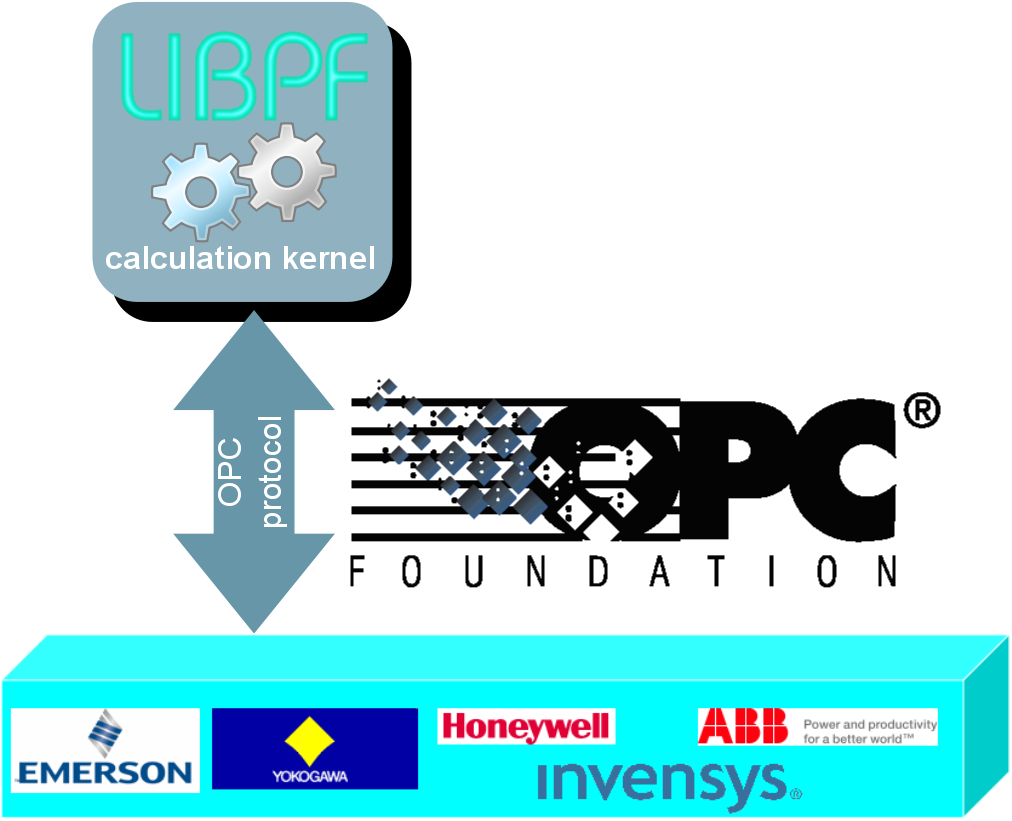
The applications of LIBPFonOPC® are:
-
Operator Training;
-
Inferential sensors;
-
Advanced process control;
-
Calculation of key performance indicators based on the actual operating conditions of the plant;
-
Monitoring of the deterioration of the characteristics of the components (fouling, loss of catalytic activity, etc.).
Functionality
The functionalities of LIBPFonOPC® are:
-
Main functions:
-
Acquiring process data from DCS;
-
Optional filtering of the data entering the calculation, in order to keep them within a range, individually specifiable for every variable [min..max];
-
Running on a regular basis the calculation of the models configured for the enabled groups as long as all the read tags are GOOD (According to the OPC DA standard, the tag status can be GOOD, BAD or UNCERTAIN);
-
Optional filtering of the results of the calculation, in order to keep them within a range individually specifiable for every variable [min..max];
-
Writing of the calculated values to conveniently arranged tags of the DCS as long as there aren’t convergence errors (in which case the group resets and the results are not written);
-
-
Configuration via the LIBPFonOPC Configurator:
-
Stopping / starting the service;
-
Configuring the main parameters (OPC server, modulation of the CPU load, prolixity of the trace messages, trace server);
-
Configuring the groups of variables (acquired variables, results and constants) with the relative models associated for the calculation;
-
-
System and monitoring functions:
-
Functioning as a service (management from the Control panel → Administrative tools → MMC Services) or as a console program (at command line);
-
Logging of the main events (starting, stopping, errors, warnings) in the “Application” event log of the operating system;
-
Detailed tracking of the progress of the program (trace) to text files or local or remote named pipe, with a modifiable degree of prolixity (verbosity) of the messages;
-
-
Modeling functions:
-
Development of any process model supported by the LIBPF® library using the C++ programming language;
-
Saving the instant state of the models with the current values of the variables on the relational database;
-
Manual input of analytic data or off-line quantities via the user interface;
-
Viewing the values present in the relational database in a user interface and interactive editing of the calculation parameters.
-
Installation, configuration and maintenance
System environment
The LIBPFonOPC® application has been developed and tested in the following system environment:
| Component | Description | Version |
|---|---|---|
| Operating system | Windows | Vista Service Pack 2 |
| 20 | ||
| Server 2012 R2 | ||
| Architecture | x86 | 32 bit |
| Development environment | Microsoft | Visual C++ 2015 update 1 |
| OPC interface | OPC DA (Data Access) | 3.0.106 (OPC Classic Core Components Developer Kit of 2015-06-24) |
| Simulator | LIBPF® | 1.0 |
Installation
The installation of LIBPFonOPC® takes place automatically via the installer:

Caution, before installing:
-
Install, configure and verify the OPC interface; you can use an OPC client such as the PI OPC Client of OSI or the free-ware MatrikonOPC Explorer;
-
Log on as an administrative user;
-
Uninstall any previous versions of LIBPFonOPC®.
To run the installer administrative access to the computer is required, so the UAC (User Account Control) will prompt for account elevation, click on “yes”:

The installer first requires you to accept the licenses for LIBPFonOPC:
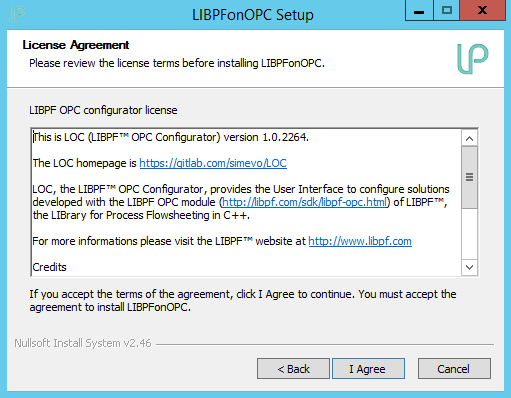
You can then choose the installation folder:
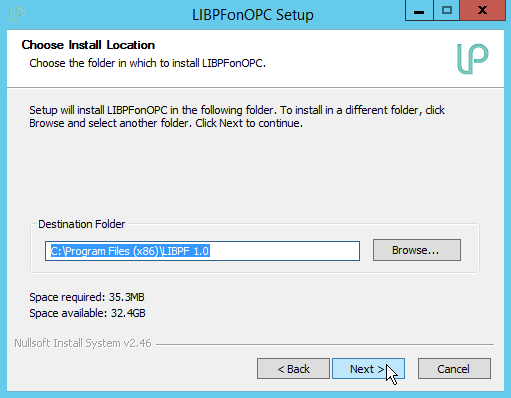
And finally you have the opportunity to change the program group in Start → Programs → (LIBPFonOPC default value).
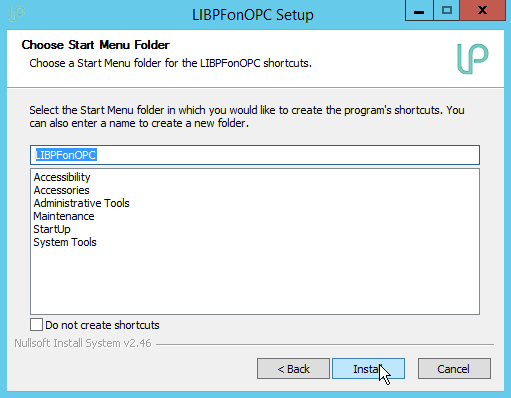
If the Microsoft Visual C++ 2015 Redistributable is not yet installed, the LIBPFonOPC installer will launch a separate installer for the redistributable, accept the license terms and conditions and click “Install”:
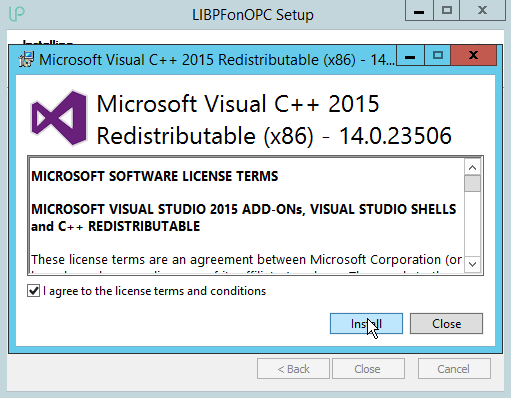
When the installation of the redistributable is complete a confirmation box appears, click “Close” to proceed:
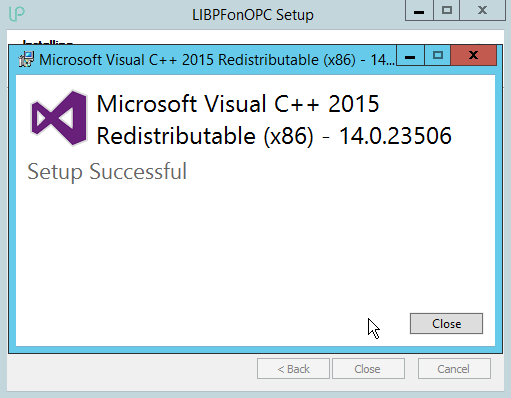
Finally the installation of LIBPFonOPC should be complete too:
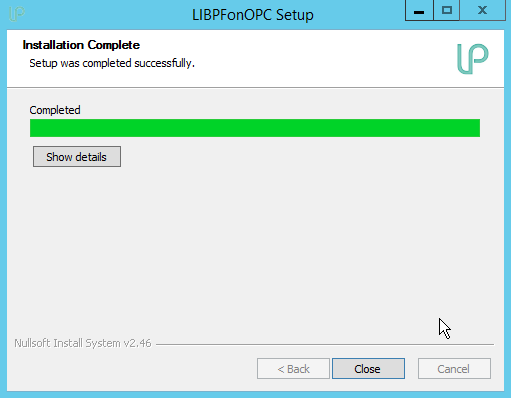
The changes to the system carried out by the installer are:
-
creation of the registry key:
HKEY_LOCAL_MACHINE\Software\libpf.com\LIBPF 1.0(i.e. the virtual key created by the registry redirectorHKEY_LOCAL_MACHINE\Software\Wow6432Node\libpf.com\LIBPF 1.0if the 32-bit version of LIBPFonOPC is installed on a 64-bit operating system) -
creation of the registry key:
HKEY_LOCAL_MACHINE\SOFTWARE\Microsoft\Windows\CurrentVersion\Explorer\ControlPanel\NameSpace\{E9958C60-DF09-11E5-A837-0800200C9A66} -
creation of the registry key:
HKEY_LOCAL_MACHINE\SYSTEM\CurrentControlSet\Services\Eventlog\Application\LIBPF -
creation of the
C:\Program Files\LIBPF 1.0folder (orC:\Program Files (x86)\LIBPF 1.0if the 32-bit version of LIBPFonOPC is installed on a 64-bit operating system) and copying of the necessary files (LIBPFonOPC.exe, LOC.exe, TraceListener.exe) -
creation of the
C:\ProgramData\LIBPF 1.0folder and copying of the necessary files (settings.xml, schema.xsd e stylesheet.xml) -
creation of the programs group Start → Programs → LIBPFonOPC with links to: LIBPFonOPC console, Trace Listener, install / uninstall LIBPFonOPC as a service, LIBPFonOPC Configurator:
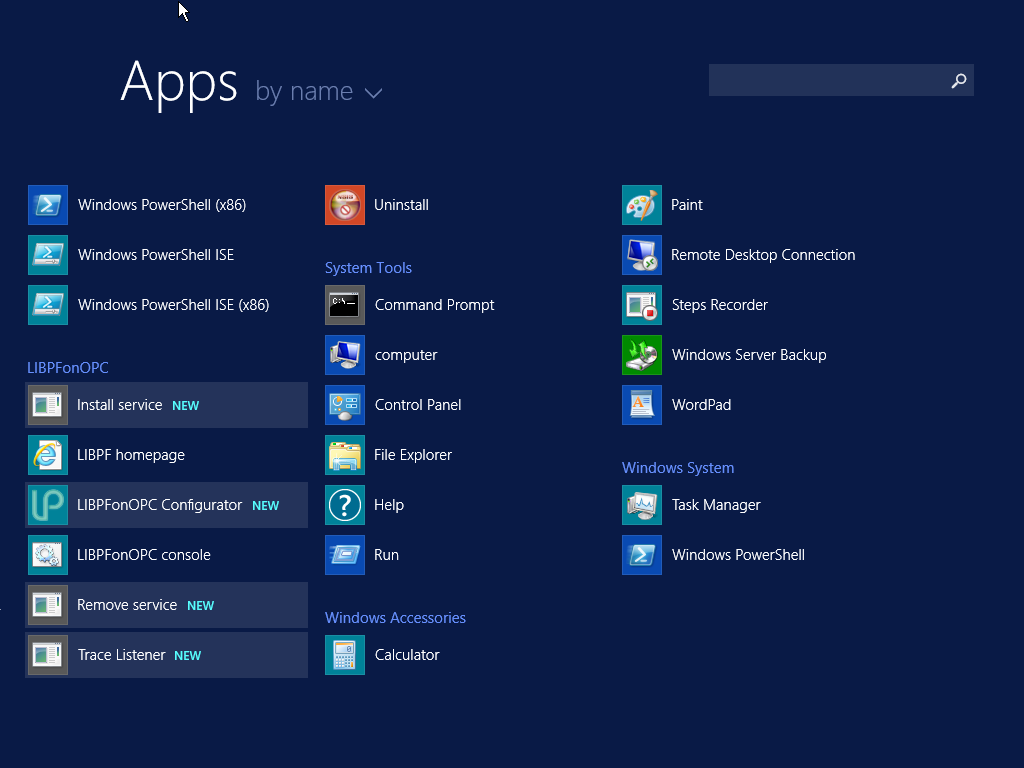
-
installation of LIBPFonOPC as a service with manual start.
Activation
When starting, LIBPFonOPC® checks if it has already been activated on that computer.
If negative it requires to proceed with the activation by accessing a specific web server to which an alphanumeric string that identifies the user’s computer will be submitted.
This site in turn calculates the activation key and returns a .reg file that will be loaded into the registry.
The activation must be performed only once for each computer where you intend to use LIBPFonOPC®. For further information please refer to the chapter “Manual activation” in the LIBPF® Activation Guide (the automatic activation is not available for LIBPFonOPC®).
Uninstalling
You can uninstall LIBPFonOPC® from Control Panel → Install / Remove Applications:
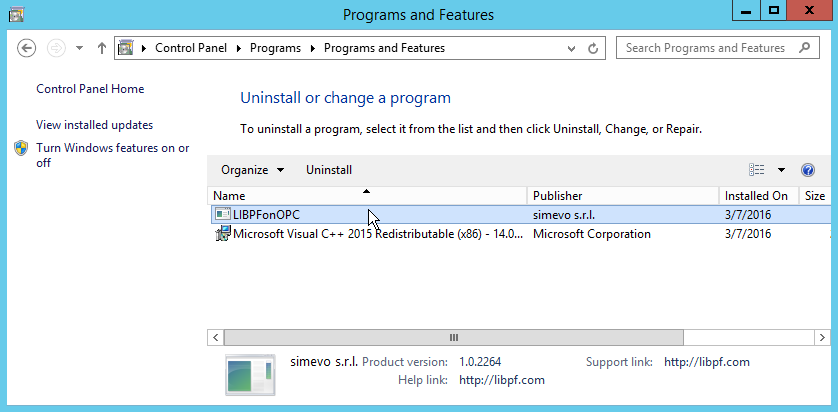
Caution, before uninstalling LIBPFonOPC®:
-
Log on as an administrative user;
-
If necessary, save the settings.xml file which might contain customized settings (Although the uninstaller saves the current version of the settings.xml file in a file with random name e.g.
nsp8.tmp.xml); -
Close the event log;
-
Close the services management console.
The uninstaller first requires a confirmation:

Once the confirmation given, the uninstalling proceeds automatically until the uninstallation complete confirmation box appears:

At the end of the uninstall process these elements will be left:
-
in the
HKEY_LOCAL_MACHINE\Software\libpf.com\LIBPF 1.0registry key, the keys associated to the activation process, to avoid having to repeat the activation process in case LIBPFonOPC® will be reinstalled later; -
in the
C:\Programs\LIBPF 1.0folder, a backup of the current settings.xml file which is saved with a random name (e.g.76rtfe.tmp.xml), in order not to accidentally lose the settings.
Caution, in certain cases the LIBPFonOPC® service is uninstalled but not removed from the list of services. In this case we suggest a reboot of the system to ensure a complete removal.